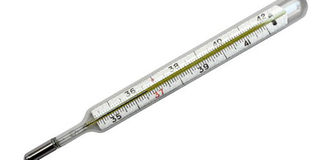This is what to do when your child gets a fever

Fever is a normal reaction to an infection, and is not an illness in itself. In fact, it should be a welcome symptom because it tells you that your child is unwell, and that he or she’s body is working to fight off the infection. PHOTO | FILE
What you need to know:
- For infants and young children, a slight increase in temperature can be a sign of a severe infection, however, the degree of fever does not necessarily signify the severity of the underlying illness.
- Depending on the cause of the fever, there could be other signs and symptoms which could include dehydration, lethargy, aching muscles, poor feeding, sweating, shivering and general body weakness.
- Most seizures stop on their own, however, take your child to hospital as soon as the seizure stops, to determine the cause.
Fever is often a sign of worry to many parents, especially when it shows no signs of abetting.
However, fever is a normal reaction to an infection, and is not an illness in itself. In fact, it should be a welcome symptom because it tells you that your child is unwell, and that he or she’s body is working to fight off the infection.
For infants and young children, a slight increase in temperature can be a sign of a severe infection, however, the degree of fever does not necessarily signify the severity of the underlying illness.
A serious condition can cause a low fever, while a minor one can cause a high fever.
OBSERVE SYMPTOMS
Fever in children can be triggered by infections such as the common cold, chickenpox, malaria and respiratory tract infections. In addition, immunisations such as pneumococcal vaccines, or teething can also cause an increase in temperature.
The most obvious sign of fever is when the temperature of a child rises above 37.5°C.
Depending on the cause of the fever, there could be other signs and symptoms which could include dehydration, lethargy, aching muscles, poor feeding, sweating, shivering and general body weakness.
Observe these symptoms and seek medical help immediately if the baby’s fever is accompanied by the following; refusal to eat or drink, breathing difficulties, the child appears to be in pain, presence of a rash, unexplained irritability, for example crying when moved, if the baby appears to be unresponsive and lethargic, and if the baby is less than three months old.
The presence of these signs in an infant or a child younger than two might indicate a serious illness.
If your child vomits repeatedly, is irritable, or has serious stomachache or headache, or any other uncomfortable symptoms, take him or her to hospital right away.
Additionally, if the fever lasts for more than 24 hours, seek medical help.
Hanna Mwangi, a paediatric nurse, gives a number of steps you can take to make your child more comfortable as you await treatment.
Dress your child in light clothes and keep him or her in a cool environment.
Give plenty of drinks, for instance diluted fruit juices or plain water since fever can cause dehydration. If the baby is below six months, breast feed him more.
Ensure that he gets enough rest to aid recovery, since too much activity can raise the body temperature.
Give a painkiller such as paracetamol or ibuprofen to help bring down the fever. Give the dosage as instructed on the packaging or consult a doctor. If the fever still does not subside, do not give any more medication, instead, see a doctor.
SEIZURE
High fevers of between 39.4 degrees Celsius and 41.1 degrees Celsius can cause irritability, confusion, hallucinations, severe dehydration, and febrile seizure (fever-induced seizure).
In case a child suffers a febrile seizure:
Remain calm
Lay the child on his stomach or side on the ground or floor
Move any objects that could hurt him
Loosen tight clothing
Do not give anything (including medicine) or try to stop the seizure
Stay with the child and note the length of seizures
Most seizures stop on their own, however, take your child to hospital as soon as the seizure stops, to determine the cause.




